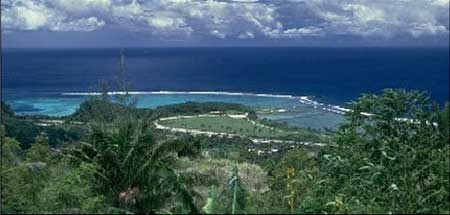|
WAR IN THE PACIFIC National Historical Park |
U.S. Deparment of the Interior National Park Service |

|

War in the Pacific National Historical Park is located on the tropical island of Guam, approximately 13 degrees north of the equator and about 3,300 miles southwest of Hawaii. On Guam there is an embracing "hafa adai" attitude that welcomes visitors and makes the island a friendly travel destination and a unique place to live in the United States.
 The Marine Landing Monument commemorates the Marines who bravely stormed Asan beach to begin the Battle of Guam, leading to the Americans liberating the island from the Japanese. National Park Service photo. |
While Guam is only 212 square miles, the island is rich in history. Only hours after Pearl Harbor was attacked, the Japanese began aerial bombings on Guam. After two days of strafing, the Japanese came ashore and hours later the naval governor surrendered the American territory. The island remained under Japanese control for 31 months until July 21, 1944 when the United States returned and liberated the island. Many lives were lost and the suffering was great for all those involved in the battles on Guam and throughout the Pacific theater. In order to remember the United States' and Guam's involvement in World War II, War in the Pacific was established in 1978 to commemorate the bravery and sacrifice of those participating in the campaigns of the Pacific Theater of World War II and to conserve and interpret outstanding natural, scenic, and historic values and objects of the island of Guam.
While the park is most noted for its historical resources, the warm climate, sandy beaches, and turquoise waters beckon visitors and residents to discover and rediscover the island's history, environment, and recreational opportunities.
DID YOU KNOW
War in the Pacific NHP has more water acres (1002) than land acres (926)?
-
The Fonte Plateau Unit was the site of a former Japanese naval communications center on Guam during World War II.
The three Japanese coastal defense guns located at the Piti unit were never fired?
That more than 50 years ago, by forced labor, the Chamorros built many of the Japanese fortification and defense structures that can be seen throughout the park and island?
Within the seven park units there are coral reefs, limestone forests, wetlands, a mahogany forest, and tropical savannah ecosystems?
War in the Pacific has one of the highest levels of species diversification within the park service and has one of the most diverse coral reefs?
During the Japanese occupation the area now known as Asan Beach Unit was a rice paddy?
 Marines crouch on beach as Japanese land mines knock out a couple of their tanks. Visiting the same site today is an amazing contrast to how these beaches looked during war time. National Park Service photo. |
DON'T MISS ATTRACTIONS
- Asan Bay Overlook with its panoramic view and its Memorial Wall
which contains 16,142 names of Chamorro and American casualties
who suffered or died during the war on Guam.
- The 20 cm short-barrel Japanese Coastal Defense Gun and the Japanese Twin Mount 25mm Anti Aircraft Gun that are located at Ga'an Point.
 Ga'an Historic guns at Ga'an point include a 20cm short-barrel Japanese Coastal Defense Gun and a Twin Mount 25mm antiaircraft gun. Ga'an point is where 55,000 US Marines and Army Infantrymen stormed the shores to begin the recapture of the island. National Park Service photo. |
- Liberator's Memorial commemorates the 50th anniversary of the Liberation of Guam. This monument honors the armed forces that participated in the 1944 landing on Guam.
- Over 3,500 marine species and 200 species of coral that are located within the scuba and snorkeling areas of park waters including the endangered hawksbill sea turtle and the threatened green sea turtle.
- Over 100 historical sites, caves, bunkers, pill boxes, emplacements, latrine foundations, plaques, and structures that can be seen throughout War in the Pacific's landscape.
NATIONAL PARK SERVICE PRIORITIES
As a result of the devastating effects of Supertyphoon Pongsona, War in the Pacific has been without a museum, contact facility, or administrative offices since December 2002. Management objectives for the upcoming year are to develop a new contact facility for park visitors, establish new administrative offices for park staff, and identify a curatorial facility.
 Ranger Ali Spittler gives a speech to the Guam Girl Scouts before they engage in planting activities as part of National Public Lands Day at Asan Beach. National Park Service photo. |
Together with the Government of Guam, the Commonwealth of the Northern Mariana Islands, and the Arizona Memorial Museum Association, the National Park Service recently made it a priority to celebrate the 60th Anniversary of the Battle of Saipan and Liberation of Guam. Events occured on Saipan and Guam in 2004 to commemorate the bravery and sacrifice of those who served and perished in the Pacific Theater of the war. Events included monthly educational programs, island-wide interpretational programs, exhibits, wreath laying ceremonies, and parades.
 This panoramic vista shows the historical Asan Invasion Beach. This is one of two beaches where on July 21, 1944, American troops came ashore to liberate the island from the Japanese. The recapture of Guam cost more than 7,000 American and about 17,500 Japanese casualties. |